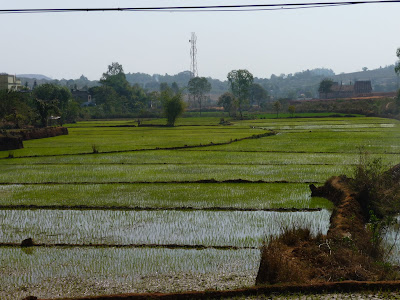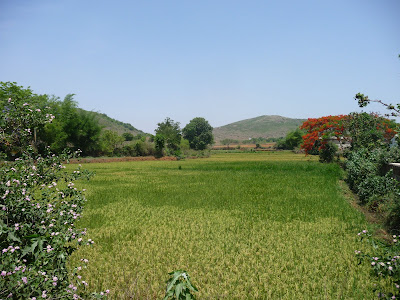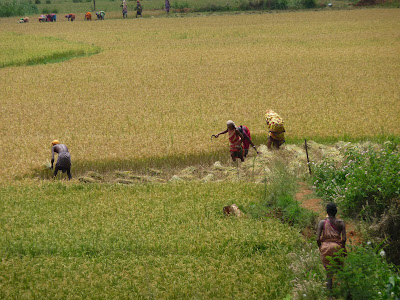Gina writes:
Every work day, I walk 1/2 mile to and from the office. One part of the walk is through a series of paddy (rice) fields, which are gorgeous at certain times of the growing cycle. In February, I took some quick photos of the plowing and the planting and the fields when they looked particularly pretty to me. Without even realizing it, I had started a series of photos, capturing something that I see every day here in India but want to remember properly back in the U.S. I continued taking pics at various stages of the crop and finished the series a few weeks ago, when the crop was harvested and the fields were prepared for the next rotation.
Here are the men and water buffalo plowing the fields. Even though the rice grows in standing water, the ground beneath still needs to be plowed.
A few days later, the women took over to transplant the seedlings from some temporary place to the fields.
It took about a week for all of the visible fields to get planted. It started to look pretty cool at about that point.
And only a month later, the bright bright green that I love so much was in full glory.
The fields were gorgeous during sunset too, some compensation if I had to work late.
As the rice grains themselves became more visible, the brights greens became less prominent, but the fields were still beautiful. Here they are at 3 months, just before harvesting.
And finally in early May, 4 months after planing, the women harvested the grains.
You probably noticed that this entire process is done by hand (or using water buffalo), no machines at all! Given the amount of rice that people in Orissa eat (average of 13 pounds per month according to this document) and the low price of rice (about 20-65 rupees per kg or 25-75 cents per pound), viewing the whole growing process made me realize how much work goes into this staple food that we take for granted.
And the growing and harvesting is only one part of the process! After harvesting, they have to separate the grains from the plant matter, a step called winnowing. Then they have to dry it so that it won't become moldy in storage. For some of India's rice, these steps are done without machines as well. I've seen women throwing the rice in the air so that the light parts blow away and have also seen the rice drying out in the sun, under the watchful eye of old village women using a huge leaf to fan the flies and chickens away from the rice!
Orissa is one of the biggest rice-producing states of India. 78% of their crop cover is paddy (link). In 2010, India produced 141.2 million tons of rice! The figure doesn't mean that much, but other than China with 200.5 million tons of production, the next highest producer was Indonesia at 66.4 million tons. By contrast, the U.S. produced 11.0 million tons. (link) With this knowledge, it's interesting to have had the opportunity to observe each step of the growing and harvesting process.
Labels: Indian Culture













